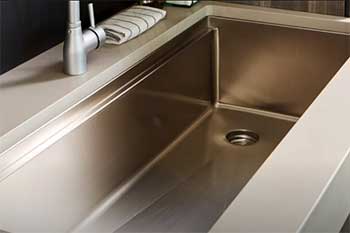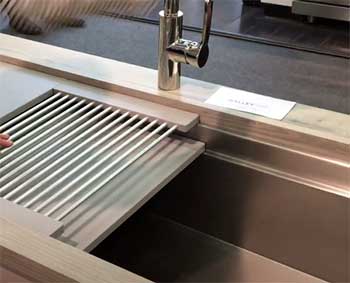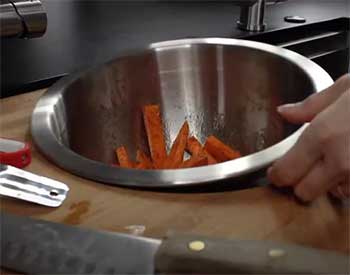When choosing a new kitchen sink, one of the first decisions you’ll need to make is whether to go with a Create Good sink or a Galley sink. Both options have their pros and cons in terms of functionality, aesthetics, and ease of maintenance.
Here’s a detailed comparison of Create Good and Galley sinks to help you determine which style is best for your kitchen.
A Brief Comparison Table
| Factor | Create Good Sink | Galley Sink |
| Basin Layout | Single large basin | Double long narrow basins |
| Basin Size | Very large, typically over 30 inches wide | Narrower, around 25 inches long by 8 inches wide |
| Basin Depth | Extra deep, usually over 9 inches | Shallower, typically 6-8 inches deep |
| Washing Function | Excellent for soaking and cleaning large items | Divided basins useful for separating wash and rinse tasks |
| Aesthetic Appeal | Bold visual statement | More understated and balanced look |
| Maintenance | Requires frequent scrubbing of large basin | Smaller basins are somewhat easier to keep clean |
| Ideal For | Washing big dishes, cookware, and bakeware | Multi-tasking and washing dishes for multiple people |
| Countertop Usage | Takes up substantial space around the sink | Compact divided basins conserve countertop real estate |
| Cost | Tends to be more expensive | Often similar in cost or cheaper than Create Good sink |
What Is A Create Good Sink?
A Create Good sink gets its name from the deep, wide basin that allows you to easily wash large pots, pans, and baking sheets. The key characteristics of a Create Good sink include:
- Large single deep basin, usually at least 9 inches deep
- Wide basin, typically 30 inches or larger
- Sides are angled or curved inward for ergonomic washing
- Often made of stainless steel for durability

The deep basin and sloped sides are designed to make it easy to fill the sink with water and maneuver dishes for washing.
Create Good sinks also make it simple to soak larger items that can’t fit in a standard sink basin.
The large single basin provides plenty of open space for washing, rinsing, and stacking dishes.
However, it can be less convenient for separating out soap suds or keeping wet and dry items separate.
Some Create Good sinks add dividers or drainboards, but the expansive basin remains the focus.
Overall, the Create Good excels at handling large loads of dishes, pots, pans, and other cumbersome items that need soaking or scrubbing. The ample basin space and depth make it easy to wash large bakeware, cookware, and platters that are trickier to clean in double basin or standard sinks.
What Is A Galley Sink?
Galley sinks take their name from the long, narrow basins resembling a ship’s galley. The key features of Galley sinks include:
- Two long equal-sized basins
- Basins are typically 21-33 inches long and 7-10 inches wide
- Depth ranges from 5-9 inches
- Divider between basins may be full or partial height
- Made of various materials like stainless steel, porcelain, etc.

With two identical basins positioned side-by-side, Galley sinks are designed for multi-tasking.
The divided layout lets you keep washing and rinsing separate.
You can also designate one basin for soaking dirty dishes and the other for scrubbing and stacking clean dishes.
The elongated basins can accommodate larger items, but the shallow depth and narrow width limit their utility for bulky pots and pans. Galley sinks also have less overall basin space compared to a sizable Create Good sink.
Galley sinks are a smart choice if you frequently cook for multiple people and have lots of dishes to wash. The divided workspace streamlines washing and rinsing simultaneously.
Key Differences Between Create Good And Galley
To summarize the key differences:
- Basin Layout – Create Good has one large basin while Galley has two long narrow basins
- Basin Size – Create Good offers more overall basin capacity
- Basin Depth – Create Good sinks are much deeper, around 9+ inches compared to 5-7 inches for Galley
- Washing Function – The Create Good’s expansive single basin is better for soaking and scrubbing large items. The Galley’s divided basins allow separating washing and rinsing.
Below is a detailed comparison of how these sink styles stack up across some important factors:
- Washing Dishes
Create Good: The expansive single basin is ideal for handling a large volume of dishes. You can soak stacks of plates, scrub pots, and rinse dishes without running out of room. The deep basin also lets you fully submerge large items.
Galley: The divided basins keep washing and rinsing separate for better workflow. However, the narrower basins limit the size of items they can accommodate and fill up quicker.
Verdict: Create Good offers more versatility for washing all types of dishes.
- Cleaning Large Cookware
Create Good: Extra deep basin and sloped sides make it easy to soak and scrub large pots and baking pans. You can fully submerge bulky items with ease.
Galley: Shallow basins and narrow openings restrict cleaning extra-large cookware. Many pots and pans won’t fit or can’t be fully immersed.
Verdict: Create Good is far superior for handling oversized cookware and bakeware.
- Food Prep
Create Good: The single spacious basin provides plenty of room for food prep tasks like cleaning vegetables, thawing meats, and draining pasta.
Galley: Divided workspace allows keeping produce separate from meat drippings or using one side just for food prep. Some Galley sinks even include cutting boards.
Verdict: Galley edges out Create Good for food prep versatility.
- Aesthetic Appeal

Create Good: Large single basin makes a dramatic visual statement.
Curved basins with sloped sides have an attractive streamlined look.
Galley: Symmetrical and compact double basin design provides a more balanced, tailored aesthetic.
Fits well in modern and traditional kitchens.
Verdict: Aesthetic preference for single vs. double basin is largely subjective.
- Maintenance
Create Good: Requires frequent cleaning to keep large basin looking pristine. Drain catchers recommended to prevent food from clogging drain.
Galley: Smaller divided basins tend to require less frequent scrubbing. Easier to keep one basin clean while using the other.
Verdict: Galley sinks are a bit easier to keep clean over time.
Pros and Cons of Create Good Sinks
Pros
- Accommodates washing large quantities of dishes, pots, pans, platters, etc.
- Deep basin allows soaking and fully submerging large items
- Sloped sides make scrubbing and scouring easier
- Provides wide open workspace
- Single basin style provides dramatic visual impact
Cons
- Not as convenient for separating washing and rinsing tasks
- Large undivided basin requires more frequent cleaning
- Limited counter space around sink due to large footprint
- Not ideal for small kitchens with limited space
Best for: Home chefs and avid home bakers who routinely wash large dishes and cookware. Also great for busy families with lots of daily dishes.
Pros and Cons of Galley Sinks
Pros
- Two basins allow you to keep washing and rinsing tasks separate
- Narrower basins take up less countertop space
- Equal sized basins create a balanced look
- Divided workspace better accommodates multiple users
- Basin dividers come in handy for food prep tasks
- Easier to keep smaller basins clean
Cons
- Basins are too narrow and shallow for large pots and pans
- Limited space for soaking and scrubbing big items
- Less overall basin capacity compared to a Create Good sink
- Dual basins lack dramatic visual impact
Best for: Busy cooks who need an efficient clean-up station. Also ideal for kitchens with limited space.
What Is The Best Style Of Kitchen Sink?
There is no definitive “best” sink style for every kitchen. The right sink depends on your needs and preferences. Here are some factors to help determine what’s best for your space:
- Kitchen Size – Galley sinks are well-suited to small kitchens, while Create Good sinks need more room.
- Cooking Habits – Frequent Use for large pots, pans, and platters favors a Create Good sink. Lots of multi-tasking and dinner parties benefit from a Galley.
- Style Preference – Create Good for a bold statement piece. Galley offers a more understated look.
- Budget – Create Good sinks come at a higher cost due to larger size and deeper basins.
- Fixtures – If adding a second sink, consider how dual Create Good or Galley sinks will fit the space.
What Kind Of Sink Is Easiest To Keep Clean?
To keep any kitchen sink clean, the key is regular upkeep and attention to detail. However, some design factors can make maintenance easier:
- Divided Basins – Separate basins prevent piles of grimy dishes from accumulating in one area.
- Shallow Basin – Requires less scrubbing than deep basins with more surface area.
- Smooth Finishes – Non-porous finishes like stainless steel resist staining and build-up.
- Drain Covers – Catchers prevent food from clogging drains and keep sinks clearer.
- Garbage Disposal – Help reduce debris and organic matter going down the drain.
- Light Colored Sinks – Make grime and stains more visible so they can be promptly removed.
- Undermount Installation – Creates a flush countertop-to-sink transition for easy wipe-downs.
Frequently Asked Questions (FAQ)
There is no universally “best” sink style. The right choice depends on your kitchen’s size, layout, and how you use it. Create Good sinks excel for handling large quantities of dishes and oversized cookware. Galley sinks are ideal if you frequently wash dishes for multiple people or prefer separate wash/rinse basins.
Top sinks for most kitchens include:
Stainless steel for durability and easy cleaning
Undermount for seamless installation
Deep basins at least 8 inches deep
Divided basin or drainboards to separate tasks
Smooth satin finish that resists fingerprints
Quiet sound insulation to prevent echoing
Designed to fit your existing cabinetry or countertop cutout
A galley sink refers to a double or split basin sink with two long, narrow basins positioned side by side. Galley sinks typically have rectangular basins around 25 inches long by 6-9 inches wide. The divided workspace allows keeping washing and rinsing separate and enables multi-tasking.
The easiest kitchen sinks to keep clean include:
Stainless steel or porcelain for non-porous surfaces
Undermount installation for flush transitions
Multiple basins to isolate messes in one section
Shallow or moderately deep basins requiring less scrubbing
Smooth satin finish that hides water spots and stains
Bottom grids and drain catchers to prevent clogged drains
Light colored sinks so grime is easy to spot
Garbage disposal to reduce food waste buildup
Final Thoughts
In summary, the Create Good’s single deep open basin excels at cleaning large cumbersome items, while the Galley’s divided workspace enables better multi-tasking and workflow. Choose based on your needs and kitchen layout.
